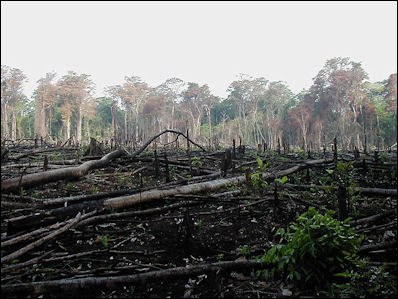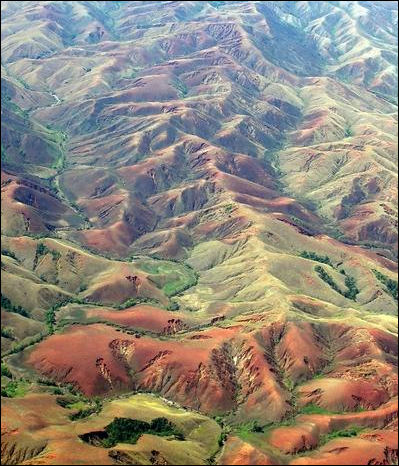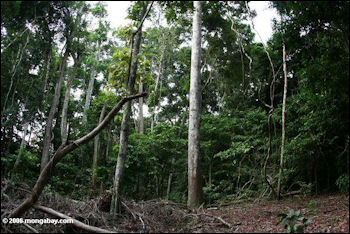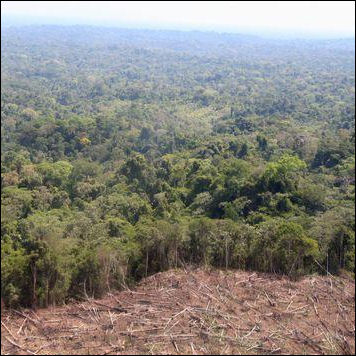RAINFOREST DEFORESTATION
burning in Lacanja Mexico. Millions of acres of rain forest disappear every year, destroying biodiversity and pouring billions of tons of carbon dioxide into the atmosphere. According to “State of the World’s Forests 2007,” 130,000 square kilometers(13 million hectares, 50,200 square miles) of rainforest, an area about the size of England, Greece or Nicaragua, is lost every year. This works out to an area the size of a football field being chopped down every four seconds and an area twice the size of Paris disappearing every day. The net loss is around 73,000 square miles (7.3 million hectares, 28,185 square miles) a year if reforestation and natural regrowth are factored in.
This is slightly better than before. It is estimated that the tropical rainforests were being cut down at an annual rate of 142,450 square kilometers (55,000 square miles), an area roughly the size of Minnesota or Great Britain, through the 1990s and early 2000s. This was nearly twice the 1980 rate of 75,110 square kilometers (29,000 square miles). The 142,450 square kilometer figure is equal to about 35 million acres or 14 million hectares or about 1 percent of the world’s rainforests. There is about 9.5 million square kilometers (3.7 million square miles) of tropical forest in the world. About half of this is undisturbed. In the 2000s, there was about 12 million square kilometers (4.6 million square miles) of tropical forest.
Estimates of rain forest size very quite a bit. Tropical rainforests once covered 14.5 million square kilometers (5.6 million square miles) — 13 percent — of Earth's surface, according to a Rainforest Foundation Norway estimate in 2021. An older estimate said that before human populations had much impact on them the world's tropical rainforests, these forests covered an area of about 32.7 million square kilometers (12.3 million square miles). In the 1990s they covered less than 12.3 million square kilometers (4.75 million square miles). The rate of deforestation has increased most dramatically in Brazil, India, Indonesia and Myanmar. Among the places that have already been largely deforested are Madagascar, the Philippines, coastal Brazil, West Africa and islands in the Caribbean and the South Pacific. There are some predictions that the remaining rainforests will largely be gone in 50 years.
Deforestation causes erosion, silting of rivers, landslides and floods. It strips water-absorbing and flood-controlling vegetation that prevents these disasters and problems. Logging, mining and roads have all played a part in the destruction of rainforests. But by most estimates over 75 percent of all tropical rainforest deforestation has been the result of ranching, and plantation and slash and burn agriculture. Of the world's remaining tropical rainforest cover, 70 percent is found in Brazil, Peru, Colombia, both parts of Papua and the Democratic Republic of Congo, which alone holds more than half of Africa's tropical rainforests.
See Separate Articles: CAUSES OF RAINFOREST DEFORESTATION factsanddetails.com; AMAZON DEFORESTATION factsanddetails.com; PEOPLE IN THE RAINFOREST: INDIGENOUS TRIBES, SETTLERS AND SLASH-AND-BURN AGRICULTURE factsanddetails.com; RAINFOREST LUMBER AND TIMBER AND PAPER COMPANIES factsanddetails.com PALM OIL AND RAIN FOREST DEFORESTATION factsanddetails.com; PALM OIL: USES, HISTORY, AGRICULTURE AND PRODUCTION factsanddetails.com; COMBATING DEFORESTATION AND EFFORTS TO SAVE THE RAINFOREST factsanddetails.com; NEW JUNGLES AND REFORESTATION factsanddetails.com
Websites and Resources: Rainforest Action Network ran.org ; Rainforest Foundation rainforestfoundation.org ; World Rainforest Movement wrm.org.uy ; Wikipedia article Wikipedia ; Forest Peoples Programme forestpeoples.org ; Rainforest Alliance rainforest-alliance.org ; Nature Conservancy nature.org/rainforests ; National Geographic environment.nationalgeographic.com/environment/habitats/rainforest-profile ; Rainforest Photos rain-tree.com ; Rainforest Animals: Rainforest Animals rainforestanimals.net ; Mongabay.com mongabay.com ; Plants plants.usda.gov ;Books: “The Private Life of Plants: A Natural History of Plant Behavior” by David Attenborough (Princeton University Press, 1997); “Portraits of the Rainforest” by Adrian Forsythe. National Geographic articles “Rainforest Canopy, the High Frontier” by Edward O. Wilson, December 1991 ▸; “Tropical Rainforests: Nature's Dwindling Treasures”, by Peter T. White, January 1983 ∩
Two-Thirds of World’s Tropical Rainforest Destroyed or Degraded

Humans have degraded or destroyed roughly two-thirds of the world's original tropical rainforest cover according to an analysis by the non-profit Rainforest Foundation Norway. Logging and land conversion, mainly for agriculture, have wiped out 34 percent of the world's original old-growth tropical rainforests, and degraded another 30 percent. The study analyzed tropical rainforests from 2002 to 2019, and found that since 2002, the area of rainforest lost is greater than the size of France. More than half of the destruction since 2002 has been in South America's Amazon and bordering rainforests.[Source: Jake Spring, Reuters, March 8, 2021]
“As more rainforest is destroyed, there is more potential for climate change, which in turn makes it more difficult for remaining forests to survive, said the report's author Anders Krogh, a tropical forest researcher. “It's a terrifying cycle," Krogh said. The total lost between just 2002 and 2019 was larger than the area of France, he found.
Reuters reported: “The rate of loss in 2019 roughly matched the annual level of destruction over the last 20 years, with a football-field's worth of forest vanishing every 6 seconds, according to another recent report by the World Resources Institute. The Brazilian Amazon has been under intense pressure in recent decades, as an agricultural boom has driven farmers and land speculators to torch plots of land for soybeans, beef and other crops. That trend has worsened since 2019, when right-wing President Jair Bolsonaro took office and began weakening environmental enforcement. But the Amazon also represents the best hope for preserving what rainforest remains. The Amazon and its neighbors — the Orinoco and the Andean rainforest — account for 73.5 percent of tropical forests still intact, according to Krogh.
“Southeast Asian islands, mostly belonging to Indonesia, collectively rank second in terms of forest destruction since 2002, with much of those forests cleared for palm oil plantations. Central Africa ranks third, with most of the destruction centered around the Congo River basin, due to traditional and commercial farming as well as logging.
“Forests that were defined in the report as degraded had either been partially destroyed, or destroyed and since replaced by secondary forest growth, Rainforest Foundation Norway said. That report's definition for intact forest may be overly strict, cautioned Tasso Azevedo, coordinator of the Brazilian deforestation mapping initiative MapBiomas. The analysis only counts untouched regions of at least 500 square km (193 square miles) as intact, leaving out smaller areas that may add to the world's virgin forest cover, he said. Krogh explained that this definition was chosen because smaller tracts are at risk of the "edge effect," where trees die faster and biodiversity is harder to maintain near the edge of the forest. A forest spanning 500 square km can fully sustain its ecosystem, he said.
History of Deforestation
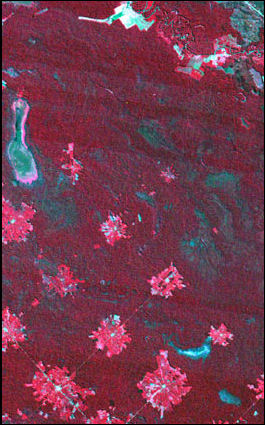
Bolivia satellite image in 1986 The Economist reported: “For at least 10,000 years, since the ice last retreated and forests took back the earth, people have destroyed them. In medieval Europe an exploding population and hard-working monks put paid to perhaps half its temperate oak and beech woods — mostly, as is usually the case, to clear space for crops. Some 100m hectares of America’s forests went in the 19th century, in an arboreal slaughter similarly reinforced by a belief in the godliness of thus “improving” the land. That spirit survives. It is no coincidence that George Bush junior, one of America’s more god-fearing presidents, relaxed by clearing brush.[Source: The Economist, September 23 2011]
In most rich countries the pressure on forests has eased; but in many tropical ones — home to around half the remaining forest, including the planet’s green rainforest girdle — the demand for land is increasing as populations rise. In Congo, which has more rainforest than any country except Brazil, the clearance is mostly driven by smallholders, whose number is about to double. Rising global demand for food and biofuels adds even more to the heat. So will climate change. That may already be happening in Canada, where recent warm winters have unleashed a plague of bark beetles, and in Australia, whose forests have been devastated by drought and forest fires.
Clearing forests may enrich those who are doing it, but over the long run it impoverishes the planet as a whole. Rainforests are an important prop to continental water-cycles. Losing the Amazon rainforest could reduce rainfall across the Americas, with potentially dire consequences for farmers as far away as Texas. By regulating run-off, trees help guarantee water-supplies and prevent natural disasters, like landslides and floods. Losing the rainforest would mean losing millions of species; forests contain 80 percent of terrestrial biodiversity. And for those concerned about the probable effects of climate change, forests contain twice as much carbon as the atmosphere, in plant-matter and the soils they cover, and when they are razed and their soils disturbed most is emitted. If the Amazon went up in smoke — a scenario which a bit more clearance and a bit more warming makes conceivable — it would spew out more than a decade’s worth of fossil-fuel emissions.
Measuring Deforestation and The Politics Involved
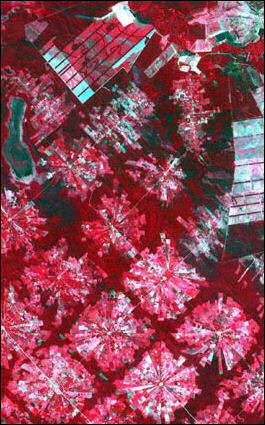
Bolivian deforestation by 2001
In the early 1980s, the U.S. National Academy of Science estimated that 50 million acres of rainforest being lost annually. The World Wildlife estimated about 25 million was lost during the same time and the United Nations agencies came up with a figure of 7.5 million. The estimates varied so widely because different criteria were used. The United Nations figure was based on the removal of all trees while the Academy of Sciences figured represented any change from virgin forest. [Source: Peter T. White, National Geographic, January 1983]
The Brazilian space agency has two systems for measuring deforestation. Prodes, a yearly satellite analysis, measures deforested areas as small as about 15 acres, while Deter, a lower-resolution system, maps areas greater than about 60 acres in real-time, giving law enforcement information to act quickly to stop further destruction. In the 2000s, Brazilian scientists began issuing reports that relied heavily on progressive deforestation, a relatively new measure that is is widely accepted by environmentalists but that some in company and industry contends is tantamount to lying. The space agency argues that this slower-paced deforestation, where parts of the forest are thinned out little by little rather than at once, can be just as devastating.
The dispute over the space agency’s figures has centered on the information provided by Deter. In the past, Gilberto Câmara, a Brazilian space agency scientists, told the New York Times the agency included mostly large swaths of cleared land in its analysis. But environmental researchers have been clamoring for years for satellite researchers to expand monitoring to include areas thinned by logging and surface fires, rather than just areas that have been clear cut. [Source: Alexei Barrionuevo, New York Times, May 25, 2008]
Decreasing Rates of Deforestation in the 2000s
Michael Lemonick wrote in National Geographic, “The news from the planet's forests has been surprisingly good lately, at least compared with the news of a decade or two ago. Globally, according to a United Nations report that came out last year, the rate at which forests are destroyed — logged or cleared to make way for farms or mines — was nearly 20 percent lower from 2000 to 2010 than it had been in the previous decade.
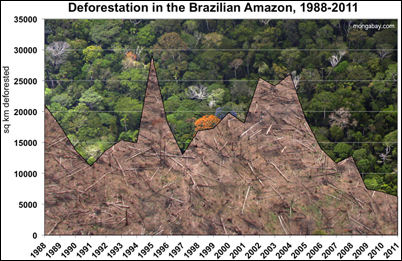
Huge tree-planting programs, especially in China, reduced the net loss of forest even further. But vast areas are still being slashed, mostly in the tropics, including each year a Switzerland-size area of previously undisturbed, ecologically precious "primary" forest. Most of those trees are burned, and the carbon stored in their wood literally goes up in smoke. Rough estimates indicate deforestation still contributes around four billion tons of planet-warming CO2 to the atmosphere each year, an eighth of the human total.
The Economist reported: “Brazil’s deforestation rate has dropped astoundingly fast. In 2004 some 2.8m hectares (10,700 square miles) of the Amazon were razed; last year only around 750,000 hectares were. This progress is not isolated. Many of the world’s biggest clearers of trees have started to hug them. Over the past decade, the UN records, nearly 8m hectares of forest a year were allowed to re-grow or were planted anew. This was mostly in richer places, such as North America and in Europe, where dwindling rural populations have taken the pressure off forestland. But a couple of big poorer countries, notably China, have launched huge tree-planting schemes in a bid to prevent deforestation-related environmental disasters. Even in tropical countries, where most deforestation takes place, Brazil is not alone in becoming more reluctant to chop down trees. [Source: The Economist, September 23, 2011]
The global recession was good for the rainforest in that it lowered demand for agricultural goods and things produced on deforested land like rubber and palm oil.
Chimpanzee Warfare and Other Results of Deforestation
Deforestation causes erosion, silting of rivers, landslides and floods. It strips water-absorbing and flood-controlling vegetation that prevents these disasters and problems.
In the 1990s scientists in Gabon noted that the population of chimpanzees had been reduced by 80 percent in areas logged in Lope National Park and the surviving animals demonstrated unusual aggressive and agitated behavior.
Logging in Gabon rain's forest reportedly touched off a chimpanzee war that may have claimed the lives of as many 20,000 chimpanzees. Even though only about 10 percent of the trees had been selectively logged in the areas where the war occurred, the lost trees seem to have set of violent territorial battles.
Biologists say the chimps near the logging areas were disturbed by the presence of humans and the noise generated by the logging machines and moved out of the area, fighting with and displacing other chimp communities, which in turn attacked their neighbor who then in turn attack their neighbors setting off a chain reaction of aggression and violence.
Deforestation and Plant and Animal Life
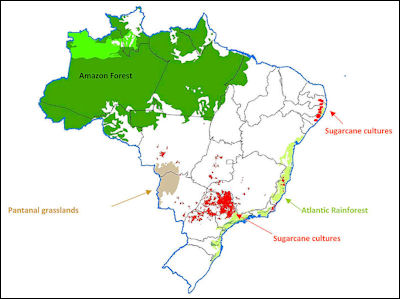
Brazil sugarcane regions
Deforested areas are not barren. The contain scrubby growth and trees that are too small to sustain a true rainforest ecosystem. It takes 500 to 1000 years for a cleared forest to return to the level of biodiversity that existed before the clearing. Selectively cleared land returns much faster. If the soil is good an "artificial forest" returns after about 30 years. If the soil isn't very good: grass and shrubs take over.«
A reduction of a tropical rainforest to one tenth its original size means an eventual loss of about half its species. In other words, if a forest of 10,000 square miles with 100 resident bird species is cut back to 1,000 square miles, it will eventually lose about 50 of the bird species. At the current worldwide rate of deforestation at least a half a percent of the world's species are lost every year. That means if the rainforest holds 10 million species, possibly 50,000 species are dying off every year, and they are vanishing 100 times faster, maybe 10,000 times faster, than new species are being created. If these numbers are accurate half the world’s species will be gone by the end of the century.
The estimates above have been arrived at by studying "islands" of trees of different sizes surrounded by cleared land. One reason why the declines have been so dramatic is that often a particular plant will rely on one species of insect or animal, say a bat for pollination,. The bat may in turn fed on a particular nectar from a fruit found elsewhere. If the bat’s food source, found in a different part of the forest, is destroyed, it might mean that the bird has to go elsewhere leaving the plant with no way to pollinate itself and thus dying.
When a rainforest is cleared generally the monkeys, large mammals and birds are the first species to go. A chimpanzee war in Gabon was blamed on a forest disturbed by logging. Some species adapt better than other to the disturbed rainforest conditions. Flycatchers spend more time foraging below the canopy than they usually would and normally arboreal animals like the tree opossum move to ground level and started eating more insects. Some animals like lorises actually do better in secondary forests than they do in virgin ones.
Disturbed Rainforest and Gap Specialists
Forests are disturbed by things like falling branches, broken off by wind or the weight of waterlogged epiphytes; heavy or diseased trees falling in shallow wet soil; burning after lightning storms; and clearing by loggers, ranchers or farmers.
In disturbed forest the remaining trees are often blown down and understory plants grow rapidly with exposure to sunlight. Tough, weedy pioneer plants invade and the "supertramp" insect populations skyrocket. An "edge effect" significantly alters the forest for at least 300 feet from the disturbed area, increasing the number of plants, animals and insects but reducing the number of species. An area in the deep rainforest might have 1,000 kinds of beetles while an area of similar size in the disturbed area might have only 300.
Some kinds of plant, called gap specialists, thrive in gaps created by physical disturbances. "When the canopy is broken up, sunlight falls more abundantly on the ground, and a new burst of vegetation springs up," Wilson wrote. "The species of trees and smaller plants in this assemblage are mostly different from those in the surrounding mature forest. So are many of the insects and animals that live on these gap specialists." ▸
Gap specialist grow thick and dominate deforested areas, river banks and clearings. They grow quickly, creating the so called impenetrable jungle. Eventually they die out when slower growing canopy trees mature, robbing the gap trees of sunlight. A mature forest at ground level is dark and has few obstacles. It is possible to walk in all directions without problems. It is only in the dense gap-filled forests that you need a machete.▸
Some scientist believe the disturbed areas may in fact be vital areas for the evolution of new rainforest species, stronger and tougher and adapted to new environments.
Deforestation, Flooding and Run Off Water
Madagascar erosion The trees and plants in a rainforest hold water like a sponge and gently distribute it the springs and streams. Without trees the water flows off the land n a great rush, eroding soil and quickly filling streams, causing floods and flood and drought conditions.
Rainforests also hold water from the wet season and slowly release it in the dry season. One study found that rivers flowing through primary forests release double the amount of water halfway through the dry season, and between three to five times more at the end of the dry season that those flowing through areas were forest have been replaced by coffee plantations.
Deforestation reduces the quality of the water that runs of the land surface and increases the amount of soil washed away. Water is cleansed when it percolates through soil with tree roots and soil that is anchored in place. It becomes dirty when the there are no roots and the soil washes away easily. One sign of a good healthy rainforest is clear river water. The slightest disturbance can set off erosion, causing the water to become muddy and brown.
A study released in 2005 by the United Nations and the Indonesia-based Center for International Forestry Research concluded that major flood was the result of major climatic patterns rather than deforestation and human elated activities such as logging and slash and burn agriculture. The study found that flooding was not significantly different in areas covered in rich forest and those that had been deforested and the floods were caused by prolonged periods of rain.
The conventional wisdom had been that forests prevented floods by acting as giant sponges, and soaking up water from heavy rains. According to the report, flooding “is a natural process that would have happened no matter what, Whether you had deforested, farmed, or logged, the amounts of water involved and the severity of these floods is just overwhelming.” Other studies have found that flooding in valleys increases after deforestation.
Erosion, Deforestation and Soil
The top soil in deforested areas is often washed way in the torrential rain storms, leaving behind laterite, a soil with a high-clay content that becomes rock-hard when it is baked by the sun, making it hard to plants t grow, and swell when it rains, blocking drainage into the ground and increasing run off.
During the dry season the trees continue to absorb water from the ground, causing the soil to dry up and crack. During the wet season, with no trees to absorb, flat areas flood and drown plant roots.
Erosion is a serious problem in deforested areas. Tree roots help aerate the soils, which means that rainfall can percolate through it, and holds the soil in place. The tree canopy and leaf litter help protect the soil form the impact fo heavy rain. With the roots and protective leaf litter the soil is easily washed away.
Erosion increases the chances of destructive mudslides and landslides by depriving slopes of trees that hold the soil in places, prevented it being releases like an avalanche in a heavy rains. Erosion also causes siltation of dams and reservoirs and clouds up rovers and streams. .
How Deforestation Helps Deadly Viruses Jump from Animals to Humans
damage caused by forest elephants The coronavirus pandemic is suspected of originating in bats and pangolins, animals associated with forests and this has brought attention to viruses that jump from wildlife to humans. Amy Y. Vittor, Maria Anice Mureb Sallum and Gabriel Zorello Laporta wrote in the The Conversation:
“These leaps often happen at the edges of the world’s tropical forests, where deforestation is increasingly bringing people into contact with animals’ natural habitats. Yellow fever, malaria, Venezuelan equine encephalitis, Ebola — all of these pathogens have spilled over from one species to another at the margins of forests. [Source:Amy Y. Vittor, Assistant Professor of Medicine, University of Florida, Maria Anice Mureb Sallum, Professor of Epidemiology, Universidade de São Paulo, and Gabriel Zorello Laporta, Professor of biology and infectious diseases, Faculdade de Medicina do ABCS, The Conversation, July 17, 2021]
“As doctors and biologists specializing in infectious diseases, we have studied these and other zoonoses as they spread in Africa, Asia and the Americas. We found that deforestation has been a common theme. More than half of the world’s tropical deforestation is driven by four commodities: beef, soy, palm oil and wood products. They replace mature, biodiverse tropical forests with monocrop fields and pastures. As the forest is degraded piecemeal, animals still living in isolated fragments of natural vegetation struggle to exist. When human settlements encroach on these forests, human-wildlife contact can increase, and new opportunistic animals may also migrate in. The resulting disease spread shows the interconnectedness of natural habitats, the animals that dwell within it, and humans.
“Yellow fever, a viral infection transmitted by mosquitoes, famously halted progress on the Panama Canal in the 1900s and shaped the history of Atlantic coast cities from Philadelphia to Rio de Janeiro. Although a yellow fever vaccine has been available since the 1930s, the disease continues to afflict 200,000 people a year, a third of whom die, mostly in West Africa.
“The virus that causes it lives in primates and is spread by mosquitoes that tend to dwell high in the canopy where these primates live. In the early 1990s, a yellow fever outbreak was reported for the first time in the Kerio Valley in Kenya, where deforestation had fragmented the forest. Between 2016 and 2018, South America saw its largest number of yellow fever cases in decades, resulting in around 2,000 cases, and hundreds of deaths. The impact was severe in the extremely vulnerable Atlantic forest of Brazil — a biodiversity hotspot that has shrunk to 7 percent of its original forest cover.
“Shrinking habitat has been shown to concentrate howler monkeys — one of the main South American yellow fever hosts. A study on primate density in Kenya further demonstrated that forest fragmentation led a greater density of primates, which in turn led to pathogens becoming more prevalent. Deforestation resulted in patches of forest that both concentrated the primate hosts and favored the mosquitoes that could transmit the virus to humans.
“Just as wildlife pathogens can jump to humans, humans can cross-infect wildlife. Falciparum malaria kills hundreds of thousands of people yearly, especially in Africa. But in the Atlantic tropical forest of Brazil, we have also found a surprisingly high rate of Plasmodium falciparum (the malaria parasite responsible for severe malaria) circulating in the absence of humans. That raises the possibility that this parasite may be infecting new world monkeys. Elsewhere in the Amazon, monkey species have become naturally infected. In both cases, deforestation could have facilitated cross-infection. We and other scientists have extensively documented the associations between deforestation and malaria in the Amazon, showing how the malaria-carrying mosquitoes and human malaria cases are strongly linked to deforested habitat.
“Another type of malaria, Plasmodium knowlesi, known to circulate among monkeys, became a concern to human health over a decade ago in Southeast Asia. Several studies have shown that areas sustaining higher rates of forest loss also had higher rates of human infections, and that the mosquito vectors and monkey hosts spanned a wide range of habitats including disturbed forest.
“Venezuelan equine encephalitis is another mosquito-borne virus that is estimated to cause tens to hundreds of thousands of humans to develop febrile illnesses every year. Severe infections can lead to encephalitis and even death. In the Darien province of Panama, we found that two rodent species had particularly high rates of infection with Venezuelan equine encephalitis virus, leading us to suspect that these species may be the wildlife hosts.
“One of the species, Tome’s spiny rat, has also been implicated in other studies. The other, the short-tailed cane mouse, is also involved in the transmission of zoonotic diseases such as hantavirus and possibly Madariaga virus, an emergent encephalitis virus. While Tome’s spiny rat is widely found in tropical forests in the Americas, it readily occupies regrowth and forest fragments. The short-tailed cane mouse prefers habitat on the edge of forests and abutting cattle pastures. As deforestation in this region progresses, these two rodents can occupy forest fragments, cattle pastures and the regrowth that arises when fields lie fallow. Mosquitoes also occupy these areas and can bring the virus to humans and livestock.
“What about the coronavirus? While the origin of the SARS-CoV-2 outbreak hasn’t been proved, a genetically similar virus has been detected in intermediate horseshoe bats and Sunda pangolins. The range of the Sunda pangolin — which is critically endangered — overlaps with the intermediate horseshoe bat in the forests of Southeast Asia, where it lives in mature tree hollows. As forest habitat shrinks, could pangolins also experience increased density and susceptibility to pathogens?
“In fact, in small urban forest fragments in Malaysia, the Sunda pangolin was detected even though overall mammal diversity was much lower than a comparison tract of contiguous forest. This shows that this animal is able to persist in fragmented forests where it could increase contact with humans or other animals that can harbor potentially zoonotic viruses, such as bats. The Sunda pangolin is poached for its meat, skin and scales and imported illegally from Malaysia and Vietnam into China. A wet market in Wuhan that sells such animals has been suspected as a source of the current pandemic.
Image Source: Mongabay mongabay.com ; Wikimedia Commons
Text Sources: “The Private Life of Plants: A Natural History of Plant Behavior” by David Attenborough (Princeton University Press, 1997); New York Times, Washington Post, Los Angeles Times, Times of London, Lonely Planet Guides, Library of Congress, Malaysia Tourism Promotion Board, Compton’s Encyclopedia, The Guardian, National Geographic, Smithsonian magazine, The New Yorker, Time, Newsweek, Reuters, AP, AFP, Wall Street Journal, The Atlantic Monthly, The Economist, Foreign Policy, Wikipedia, BBC, CNN, and various books, websites and other publications.
Last updated April 2022

